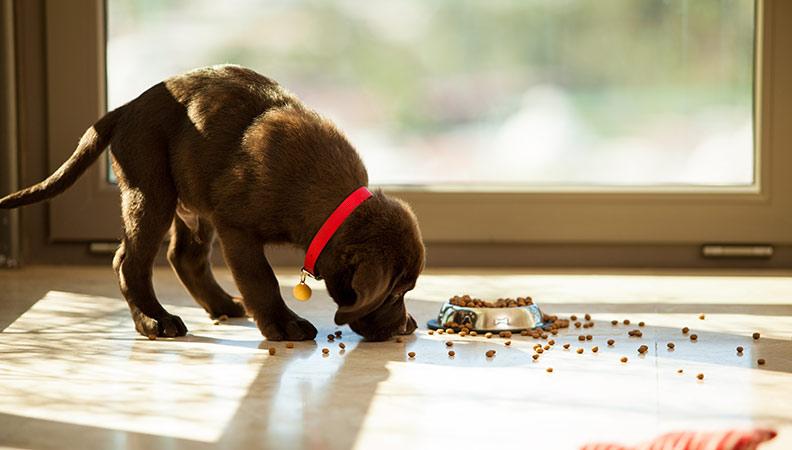
It’s important that puppies and adult dogs are fed a nutritious, well-balanced diet that's suited to their age, breed and energy requirements.
The most rapid growth period occurs during the first 6 months of a puppy’s life. A dog’s bodyweight at maturity is 40 to 50 times their birthweight.
The aim should always be for steady, controlled growth. Switching to adult dog food too early can cause your pup to grow too quickly, while switching from puppy food too late can stunt your dog's growth.
These scenarios can lead to problems with their bones and joints. Feeding puppies the correct diet is vital for healthy growth, so you should only make the switch when they're ready.
Feeding Recommendation for Puppies
Pups and young growing dogs have different nutrient requirements from adult dogs. If over-fed and given a diet that over-supplements with unnecessary nutrients and minerals, it can cause severe and permanent damage to their bones and joints.
Being overweight while their bones and joints are growing increases the risk of conditions like arthritis, hip and elbow dysplasia, and osteochondritis/osteochondrosis in genetically predisposed breeds.
Large and giant breeds (like a Great Dane for example) are particularly prone to the dangerous effects of over-feeding and over-supplementation with calcium or vitamin D. To allow these dogs to develop properly, feed carefully, ensuring there's no rapid weight gain, and activity levels should be moderate and regular.
Large Breed Puppy Feeding Guidelines
As different breeds of dogs mature at different rates, some large breeds may not be skeletally mature until around 18 months of age, while a small breed may have stopped growing at around 6 to 8 months of age. Always aim for average growth rate for the breed of dog.
Most reputable dog food manufacturers make growth or junior foods that supply the young dog with all the essential nutrients needed for normal growth and bone development. Many also produce diets specifically designed for large and giant breeds.
There’s no need to give any form of vitamin or mineral supplement to your dog except under specific veterinary advice.
When to Stop Feeding Puppies Puppy Food?
It can be hard to know when to switch your puppy to adult food. Most dogs reach 50% of adult weight by 5-6 months, but significant breed differences exist.
Dogs are often considered to have reached maturity or have become adults when they’re one year or older. But not all breeds reach maturity at the same age.
When a puppy reaches adulthood depends on their size and breed. Larger breeds develop more slowly than smaller or medium-sized breeds and so will require puppy food for longer. If you’re unsure when to switch to adult food, ask your vet for advice. They can also help if you have a mixed breed dog, and you’re unsure how big your dog will get.
- Toy and Small Breed Dogs (adult weight <10 kg): between 9 and 10 months to reach maturity
- Medium Dog Breeds (adult weight 10-25 kg): around 12 months of age to reach maturity
- Large (adult weight 25-40 kg) and Giant Breeds (adult weight >40 kg): around 18 months to 2 years to reach maturity; these dogs will need to eat puppy food longer than smaller breeds
How to Make the Transition to Adult Dog Food
As puppy food is higher in calories and is more nutrient rich than adult food, you'll need to change the number of meals and portion sizes as well as the type of food.
As puppies have small tummies, they’re usually fed three or four meals a day, while adult dogs have one or two meals per day. The feeding guide on your dog’s food packaging will have information on the amount of adult food or puppy food you should provide, and how often.
A sudden change in diet can cause digestive upsets so it’s best to make any changes gradually. You can do this by gradually introducing the new food. Mix one quarter of the new food to their usual diet and add more over the course of a week to 10 days. Making the transition slowly will increase the chances that the new food will be accepted as well.
- Days 1-2: 75% old food, 25% new food
- Days 3-4: 50% puppy food, 50% new adult food
- Days 5-7: 25% puppy food, 75% new adult food
- Days 8-10: 100% new adult food
Measuring Healthy Puppy Growth
To make sure your pooch is growing at a healthy rate, they should be weighed and have their body condition scored regularly. Leverage a puppy growth chart to check they’re putting on weight at the correct rate.
Too fast a growth rate should be avoided, especially in large and giant breeds. These dogs naturally develop slowly and must be allowed to do this if they’re to avoid bone and joint problems like arthritis. Strict portion-controlled feeding may be necessary if there’s too much weight gain.
In general, switching to adult food usually happens when puppies are 1 year old for small breeds and 2 years for large breeds. Avoid over-feeding young and growing dogs and always feed a food from a reputable manufacturer that is appropriate for your dog’s age and breed.
Everypaw Puppy Insurance
Everypaw's Puppy Insurance comes with 24/7 unlimited access to vets and vet nurses that can help with your pet's health, care, nutrition and behaviour. So you can rest assured your pup will be well looked after.
Content reviewed by Vetstream Canis - https://www.vetlexicon.com/treat/canis
Vetstream’s Vetlexicon is the world’s largest peer-reviewed online clinical reference source. All our content is written and peer-reviewed by over 1,000 of the world’s leading veterinarians, ensuring relevance, accuracy and quality.
- Vetstream Ltd (online) Feeding your puppy. In: Vetlexicon Canis. Vetstream Ltd, UK. Website: https://www.vetlexicon.com/treat/canis/client-information/feeding-your-puppy
- Francis Kallfelz, Richard C Nap (online) Dietary requirements: growth. In: Vetlexicon Canis. Vetstream Ltd, UK. Website: https://www.vetlexicon.com/treat/canis/freeform/dietary-requirements-growth